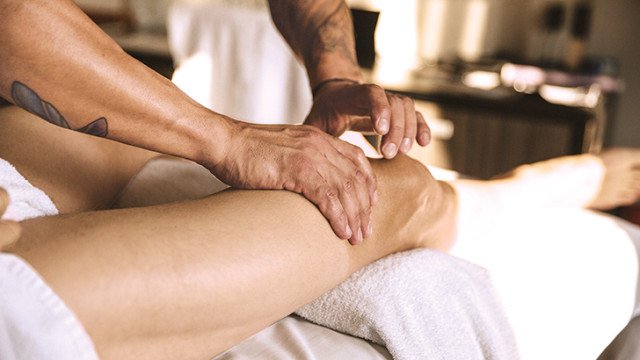The Real Reason You Need a Massage
Research suggests that a post-ride rubdown strengthens your heart as well as your muscles.
Research suggests that a post-ride rubdown strengthens your heart as well as your muscles. By Selene Yeager

Long hours in the saddle and hard workouts can leave your muscles riddled with knots and scar tissue created as they repair themselves. And because all your muscles are connected, those sore spots can spread throughout your body if not treated—a tight lower back creates an achy hip that leads to a twinged knee. That’s why so many cyclists swear by massages. They help loosen tight spots, flush toxic chemicals, and keep your fibres smooth and limber so you can ride pain free.
A study has found that the same benefits that relieve post-exercise pain might also boost heart health. Researchers in Chicago asked 25 volunteers to crank out leg presses until their quads and hamstrings cried uncle. Then half of them received a massage. A separate group of 11 received a rubdown without doing any exercise. Researchers tested all the subjects in two key areas: soreness and blood flow.
The first set of findings confirmed what many of us already know—a good massage helps reduce muscle pain after a hard workout. The exercisers who received a rubdown reported that they were free of soreness 90 minutes later, while the exercise-only folks were still hobbling the next day.
More surprising were the results of a second test that measured blood flow through the subjects’ arms. Researchers found that leg pressers who received a massage enjoyed improved circulation for up to 72 hours. Compare that with the exercise-only group, which experienced hampered circulation for more than 48 hours. Because researchers tested circulation levels in a part of the body far from where the subjects received a rubdown, the results suggest that massage triggers a full-body response that improves blood flow.
[quote]”That’s important because, as we showed, exercise-induced muscle damage slows circulation,” says co-author Shane A. Phillips, PhD, of the University of Illinois, Chicago. It also suggests that massage could promote cardiovascular health off the bike as well, he says. That’s a compelling reason to get regular rubdowns, even if you’re not training hard.[/quote]
How They Work
When a massage therapist glides his or her hands across your muscles, blood vessels open and waste can be flushed. This helps reduce tenderness after a hard ride or workout. “The increase in blood flow speeds recovery from muscle injury by providing more nutrition to the tissue and maybe also by improving the removal of waste products,” explains Phillips.
Massages also have a rejuvenating effect. When muscles are stressed, the fibres of the fascia that cover them suffer micro-tears. As they heal, these fibers become stronger, but they also can form scar tissue, called adhesions, which can limit your range of motion and cause discomfort. Deep pressure applied by a therapist to the fascia breaks up these adhesions. You’re left feeling fresh and rejuvenated and ready to tackle the next big climb.
When to Get Them
Timing is everything when it comes to massage. Wait too long and those adhesions will tighten and multiply. Here is a timetable from licensed massage therapist Janine Verstraeten, who has worked with the Specialized-lululemon and US national teams.
Before a big race or event: Go for a deep-tissue massage three to five days before a physically demanding ride to break up adhesions and ensure your muscles move freely. Verstraeten also recommends going for an easy spin and then lightly rubbing your muscles one to two days before the event to boost blood flow and flush out waste. You can use your hands, a foam roller, or a massage stick.
Following a strenuous effort: Your muscles will be sore, so get a light rubdown within 48 hours of the event (try a softer Swedish massage or give yourself a quick kneading). When your muscles are less tender—three to five days later—get a deeper rubdown to break up adhesions before they become tight and painful.
For regular maintenance: If you ride several times a week, a monthly massage will help keep your muscles limber and free of knots. Opt for a deep-tissue rubdown, which might also include trigger-point therapy (concentrated pressure to loosen isolated, painful spots). If you are training hard, Verstraeten recommends a massage every two weeks. Casual cyclists should get one as needed.
Related: Foam Roller Exercises for Cyclists
READ MORE ON: injury-prevention lifestyle training programmes

